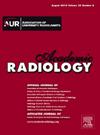基于深度学习的加速脊柱 MRI 图像重建:与标准 MRI 的前瞻性比较。
IF 3.8
2区 医学
Q1 RADIOLOGY, NUCLEAR MEDICINE & MEDICAL IMAGING
引用次数: 0
摘要
理论依据和目标:评估深度学习(DL)重建磁共振成像与标准护理(SOC)磁共振成像相比,在图像采集时间、整体图像质量和诊断互换性方面的性能:这项前瞻性研究招募了 2023 年 7 月至 2023 年 8 月期间患有脊柱不适的参与者。所有参与者都接受了两次单独的磁共振成像检查(标准扫描和加速扫描)。计算信噪比(SNR)、对比度与噪声比(CNR)和相似度指标,以进行定量评估。由四位放射科医生进行主观质量和病变特征评估。采用 Wilcoxon 检验来评估 DL 和 SOC 在 SNR、CNR 和主观图像质量方面的差异。此外,还使用个体等效指数测试了脊柱各种病变的互换性。结果:共纳入 200 名参与者(107 名男性患者,平均年龄(46.56 ± 17.07)岁)。与 SOC 相比,DL 使扫描时间缩短了约 40%。DL 的信噪比(SNR)和 CNR 明显高于 SOC(P 结论:与 SOC 相比,DL 的扫描时间缩短了约 40%:与 SOC 相比,DL 可为诊断提供高质量图像,并缩短患者的检查时间。在检测各种脊柱异常方面,DL 可与 SOC 互换使用。本文章由计算机程序翻译,如有差异,请以英文原文为准。
Accelerated Spine MRI with Deep Learning Based Image Reconstruction: A Prospective Comparison with Standard MRI
Rationale and Objectives
To evaluate the performance of deep learning (DL) reconstructed MRI in terms of image acquisition time, overall image quality and diagnostic interchangeability compared to standard-of-care (SOC) MRI.
Materials and Methods
This prospective study recruited participants between July 2023 and August 2023 who had spinal discomfort. All participants underwent two separate MRI examinations (Standard and accelerated scanning). Signal-to-noise ratios (SNR), contrast-to-noise ratios (CNR) and similarity metrics were calculated for quantitative evaluation. Four radiologists performed subjective quality and lesion characteristic assessment. Wilcoxon test was used to assess the differences of SNR, CNR and subjective image quality between DL and SOC. Various lesions of spine were also tested for interchangeability using individual equivalence index. Interreader and intrareader agreement and concordance (κ and Kendall τ and W statistics) were computed and McNemar tests were performed for comprehensive evaluation.
Results
200 participants (107 male patients, mean age 46.56 ± 17.07 years) were included. Compared with SOC, DL enabled scan time reduced by approximately 40%. The SNR and CNR of DL were significantly higher than those of SOC (P < 0.001). DL showed varying degrees of improvement (0–0.35) in each of similarity metrics. All absolute individual equivalence indexes were less than 4%, indicating interchangeability between SOC and DL. Kappa and Kendall showed a good to near-perfect agreement in range of 0.72–0.98. There is no difference between SOC and DL regarding subjective scoring and frequency of lesion detection.
Conclusion
Compared to SOC, DL provided high-quality image for diagnosis and reduced examination time for patients. DL was found to be interchangeable with SOC in detecting various spinal abnormalities.
求助全文
通过发布文献求助,成功后即可免费获取论文全文。
去求助
来源期刊

Academic Radiology
医学-核医学
CiteScore
7.60
自引率
10.40%
发文量
432
审稿时长
18 days
期刊介绍:
Academic Radiology publishes original reports of clinical and laboratory investigations in diagnostic imaging, the diagnostic use of radioactive isotopes, computed tomography, positron emission tomography, magnetic resonance imaging, ultrasound, digital subtraction angiography, image-guided interventions and related techniques. It also includes brief technical reports describing original observations, techniques, and instrumental developments; state-of-the-art reports on clinical issues, new technology and other topics of current medical importance; meta-analyses; scientific studies and opinions on radiologic education; and letters to the Editor.
 求助内容:
求助内容: 应助结果提醒方式:
应助结果提醒方式:


